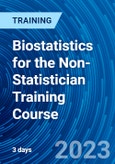Learn clinical biostatistics course for the Non-Statistician
The objective of this seminar is to provide every trainee with the information and skills that are mandatory to comprehend numerical concepts and answers as smears to scientific study and to positively convey the information to others.
Statistics is a valuable tool that is good and useful for making decisions in the medical research arena. When employed in a field where a p-value can determine the next steps in the development of a drug or procedure, it is authoritative that choice makers comprehend the philosophy and request of statistics.
Quite a few numerical software is now available to professionals. However, this software was industrialized for geometers and can often be unnerving to non-statisticians. How do you know if you are persistent in the right key, let unaided execution be the best test.
This seminar on medical biostatistics online course provides a non-mathematical introduction to biostatistics and is designed for non-statisticians. And it will profit specialists who must comprehend and work with study design and clarification of findings in a scientific or biotechnology setting.
Stress will be placed on the real numerical (a) concepts, (b) application, and (c) interpretation, and not on mathematical formulas or actual data analysis. A basic understanding of statistics is desired, but not necessary.
The seminar Includes Certificate, PDF copy of the Handouts, Q/A Session, Live Instructor-led 3 Days Web Seminar & Statistical Analysis Plan Template provided by the faculty.
Learning objectives
The aim of this seminar is to educate you on enough statistics to:
- Perform simple analyses in statistical software.
- Avoid being misinformed by unwise findings.
- Communicate statistical findings to others more clearly.
- Comprehend the numerical portions of the greatest articles in medical journals.
- Do simple calculations, particularly ones that aid in interpreting published literature.
- Knowledge of which test when, why, and how.
Course Content
Agenda Day 1: Basics
Course Provider

Ms Elaine Eisenbeisz,
Owner & Principal ,
Omega StatisticsElaine Eisenbeisz is a private practice statistician and owner of Omega Statistics, a statistical consulting firm based in Southern California. Elaine has over 30 years of experience in creating data and information solutions for industries ranging from governmental agencies and corporations, to start-up companies and individual researchers.
Elaine’s love of numbers began in elementary school where she placed in regional and statewide mathematics competitions. She attended the University of California, Riverside, as a National Science Foundation scholar, where she earned a B.S. in Statistics with a minor in Quantitative Management, Accounting. Elaine received her Master’s Certification in Applied Statistics from Texas A&M, and is currently finishing her graduate studies at Rochester Institute of Technology.
Who Should Attend
- Physicians
- Medical Writers who need to interpret statistical reports
- Clinical Project Managers/Leaders
- Clinical Research Associates Sponsors
- Regulatory Professionals who use statistical concepts/terminology in reporting
- Clinical research organizations, hospitals, and researchers in health and biotech fields.
- People engaged in the medical sciences, medicinal and or nutraceutical industries, scientific trials, scientific research, and clinical research administrations, physicians, medicinal students, graduate students in the biological sciences, researchers, and medical writers who need to interpret statistical reports.









